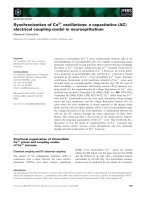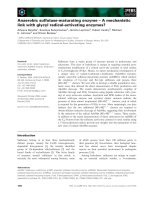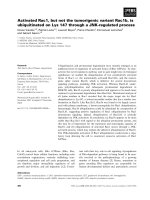Báo cáo khoa học: "Lynch syndrome: still not a familiar picture" pptx
Bạn đang xem bản rút gọn của tài liệu. Xem và tải ngay bản đầy đủ của tài liệu tại đây (200.82 KB, 3 trang )
BioMed Central
Page 1 of 3
(page number not for citation purposes)
World Journal of Surgical Oncology
Open Access
Case report
Lynch syndrome: still not a familiar picture
Frederik J Hes
Address: Center for Human and Clinical Genetics (CHKG), Department of Clinical Genetics, Leiden University Medical Center (LUMC), RC
Leiden, The Netherlands
Email: Frederik J Hes -
Abstract
Background: Germ line mutations in mismatch repair genes underlie Lynch syndrome and
predispose carriers for colorectal carcinoma and malignancies in many other organ systems.
Case presentation: A large Lynch syndrome family with 15 affected family members and
involvement in 7 organs is reported. It illustrates a lack of awareness and knowledge about this
hereditary tumor syndrome among doctors as well as patients. None of the described family
members underwent presymptomatic screening on the basis of the family history.
Conclusion: Hereditary features, like young age at diagnosis, multiple tumors in multiple organs
and a positive family history, should lead to timely referral of suspected cases for genetic counseling
and diagnostics. For Lynch syndrome, these features can be found in the Amsterdam and Bethesda
criteria. Subsequently, early identification of mutation carriers might have diminished, at least in
part, the high and early morbidity and mortality observed in this family.
Background
Colorectal carcinoma (CRC) is an important cause of can-
cer-related death in the Western world. The lifetime risk is
about 5% and is rising [1]. Currently, about 5% of all CRC
cases can currently be explained by known inherited
tumor syndromes. The most common of the known CRC
predisposing syndromes is Lynch syndrome (previously
also annotated as hereditary non-polyposis colorectal can-
cer; HNPCC) which is characterized by the development
of CRC, endometrial cancer and various other cancers [2].
This tumor syndrome is caused by a mutation in one of
the mismatch repair (MMR) genes: MLH1, MSH2, MSH6
or PMS2. Tumors observed in Lynch syndrome families
are diagnosed at an unusual early age and may be multi-
ple. The MMR-defect leads to instability at microsatellites
of tumor-DNA that is called microsatellite instability
(MSI). Subsequently, with immunohistochemical (IHC-)
analysis using antibodies against the four MMR-proteins,
loss of protein expression of the causative gene can be
demonstrated. In order to standardize clinical and basic
research the Amsterdam criteria were first published in
1991 and revised in 1999 [3,4]. In 1997, the Bethesda
guidelines were developed to select patients that should be
tested for MSI and IHC. These guidelines were revised in
2004 [5,6]. The revised Amsterdam criteria and Bethesda
guidelines are shown in Table 1. These guidelines have
enabled the recognition of vast numbers of affected fami-
lies, and germline mutation analysis of the MMR-genes
has led to identification of many (asymptomatic) family
members at risk for Lynch syndrome. However, this case
report illustrates a lack of awareness about this hereditary
tumor syndrome among doctors as well as patients.
Case presentation
In November 2006, a 56-year old woman (III-1 in pedi-
gree, Figure 1) visited our clinic for genetic counseling
Published: 20 February 2008
World Journal of Surgical Oncology 2008, 6:21 doi:10.1186/1477-7819-6-21
Received: 18 December 2007
Accepted: 20 February 2008
This article is available from: />© 2008 Hes; licensee BioMed Central Ltd.
This is an Open Access article distributed under the terms of the Creative Commons Attribution License ( />),
which permits unrestricted use, distribution, and reproduction in any medium, provided the original work is properly cited.
World Journal of Surgical Oncology 2008, 6:21 />Page 2 of 3
(page number not for citation purposes)
because she was worried about the many cases of cancer
that had occurred in her family. The direct reason for her
visit was the recent death of her 39-year old son (IV-1)
with a symptomatic, and already metastasized, rectal ade-
nocarcinoma. The counselee had been diagnosed with an
endometrial and a sigmoid carcinoma at age 53- and 54-
years old, respectively. She reported her overwhelming
family history, which easily fulfilled the criteria that ena-
ble selection of families that are at risk for Lynch syn-
drome (Table 1). Subsequent IHC-analysis on archival
tumor material of her sigmoid carcinoma demonstrated
abrogation of the MSH2 and MSH6 proteins, which is typ-
ically associated with a germline MSH2 mutation. Multi-
plex ligation-dependent probe amplification (MLPA), in
DNA extracted from peripheral lymphocytes, identified
an entire MSH2 gene deletion (exons 1–16) and con-
firmed the diagnosis of Lynch syndrome.
In retrospect, some doctors had indeed signaled notewor-
thy features in this family. First, in 1979, a gynecologist
who was treating patient II-6 consulted a colleague about
the very early onset of endometrial carcinoma. His col-
league reassured him at that time that the age at presenta-
tion, 41 years old, was not in fact very rare. Second, in
2005, a gastroenterologist spoke of possible HNPCC in
patient III-2, who was diagnosed with carcinoma of the
papilla of Vater after she had developed three separate
colon carcinomas, but no further action was taken. Third,
in 2006, an oncologist treating patient IV-1 suggested MSI
testing on tumor material after his mother (III-1) had
expressed her concern about the family history, but did
not proceed.
Table 1: Amsterdam criteria II and revised Bethesda guidelines.
Amsterdam criteria II
There should be at least three relatives with colorectal cancer (CRC) or with a Lynch syndrome associated cancer: cancer of the endometrium,
small bowel, ureter or renal pelvis.
- one relative should be a first-degree relative of the other two;
- at least two successive generations should be affected,
- at least one tumor should be diagnosed before the age of 50 years,
- FAP should be excluded in the CRC case if any,
- tumours should be verified by histopathological examination.
Revised Bethesda guidelines
1. CRC diagnosed in a patient aged <50 years.
2. Presence of synchronous, metachronous colorectal, or other Lynch syndrome-related tumours*, regardless of age.
3. CRC with MSI-high phenotype diagnosed in a patient aged < 60 years.
4. Patient with CRC and a first-degree relative with a Lynch syndrome-related tumor, with one of the cancers diagnosed aged <50 years.
5. Patient with CRC with two or more first-degree or second-degree relatives with a Lynch syndrome-related tumor, regardless of age.
*Lynch syndrome related tumours include colorectal, endometrial, stomach, ovarian, pancreas, ureter, renal pelvis, biliary tract, and brain tumours,
sebaceous gland adenomas and keratoacanthomas and carcinoma of the small bowel
Pedigree of a Lynch syndrome family, showing organ systems and age of diagnosis, see legendFigure 1
Pedigree of a Lynch syndrome family, showing organ systems and age of diagnosis, see legend. Year, year of diag-
nosis/diagnoses; asterisk, anamnestically obtained information; urinary tract, urothelial carcinoma of renal pelvis or ureter; skin,
keratoacanthoma; asc., ascending colon; transv., transverse colon; desc., descending colon.
Publish with BioMed Central and every
scientist can read your work free of charge
"BioMed Central will be the most significant development for
disseminating the results of biomedical research in our lifetime."
Sir Paul Nurse, Cancer Research UK
Your research papers will be:
available free of charge to the entire biomedical community
peer reviewed and published immediately upon acceptance
cited in PubMed and archived on PubMed Central
yours — you keep the copyright
Submit your manuscript here:
/>BioMedcentral
World Journal of Surgical Oncology 2008, 6:21 />Page 3 of 3
(page number not for citation purposes)
Discussion
This family is a fine example of the plethora of tumors
that may occur in Lynch syndrome and demonstrates why
the term Lynch syndrome is preferred nowadays over
HNPCC (hereditary non-polyposis colorectal cancer),
which only refers to CRC. The organ involvement in this
family included seven organ systems: colon, uterus, skin,
stomach, urinary tract, pancreas and hepatobiliary system.
The manifestation of keratoacanthoma in this family ena-
bled a sub-classification to Muir Torre syndrome (MTS).
MTS is a variant of Lynch syndrome and germline muta-
tions in the three main Lynch syndrome genes (MLH1,
MSH2 and MSH6) have been identified in MTS families
[7,8]. Keratoacanthoma should be regarded as one of the
tumors that lie in the constellation of Lynch syndrome
but their manifestation could depend on modifier genes
and/or environmental factors.
This case report shows a considerable delay in diagnosing
Lynch syndrome which negatively influenced the man-
agement of many family members. None of the family
members underwent presymptomatic screening on the
basis of the family history, while clinical surveillance has
been shown to decrease mortality in Lynch syndrome
families [9]. Remarkably, in none of the medical reports
we obtained was a family history reported extending fur-
ther than first-degree relatives.
Conclusion
This family clearly illustrates a lack of awareness about a
hereditary tumor syndrome among doctors as well as
patients. In general, it is prudent to be aware of classic
hereditary features, like young age at diagnosis, multiple
tumors in multiple organs and a positive family history,
and to refer suspected cases for genetic counseling. More
specifically, these features can be found in the Amsterdam
and Bethesda criteria (Table 1). Subsequently, the identi-
fication of at-risk persons will optimize the timing and
efficiency that surveillance and treatment are carried out.
Abbreviations
CRC: colorectal cancer; HNPCC: hereditary non-polypo-
sis colorectal cancer; IHC: immunohistochemistry; MSI:
microsatellite instability; MLPA: multiplex ligation-
dependent probe amplification; MTS: Muir Torre syn-
drome
Competing interests
The author(s) declare that they have no competing inter-
ests.
Authors' contributions
FJH contributed to conception and design, acquisition of
data, analysis and interpretation of data. He also drafted
the manuscript and gave final approval of the version to
be published.
Acknowledgements
Written permission was obtained from the index-patient for publication of
this case report. The author should like to thank Dr. C.M.J. Tops for carry-
ing out the molecular genetic studies and Prof. H. Morreau for immunohis-
tochemical analysis.
References
1. Boyle P, Langman JS: ABC of colorectal cancer: Epidemiology.
BMJ 2000, 321:805-808.
2. Vasen HF, Moslein G, Alonso A, Bernstein I, Bertario L, Blanco I, Burn
J, Capella G, Engel C, Frayling I, Friedl W, Hes FJ, Hodgson S, Mecklin
JP, Moller P, Nagengast F, Parc Y, Renkonen-Sinisalo L, Sampson JR,
Stormorken A, Wijnen J: Guidelines for the clinical manage-
ment of Lynch syndrome (hereditary non-polyposis cancer).
J Med Genet 2007, 44:353-362.
3. Vasen HF, Mecklin JP, Khan PM, Lynch HT: The International Col-
laborative Group on Hereditary Non-Polyposis Colorectal
Cancer (ICG-HNPCC). Dis Colon Rectum 1991, 34:424-425.
4. Vasen HF, Watson P, Mecklin JP, Lynch HT: New clinical criteria
for hereditary nonpolyposis colorectal cancer (HNPCC,
Lynch syndrome) proposed by the International Collabora-
tive group on HNPCC. Gastroenterology 1999, 116:1453-1456.
5. Rodriguez-Bigas MA, Boland CR, Hamilton SR, Henson DE, Jass JR,
Khan PM, Lynch H, Perucho M, Smyrk T, Sobin L, Srivastava S: A
National Cancer Institute Workshop on Hereditary Non-
polyposis Colorectal Cancer Syndrome: meeting highlights
and Bethesda guidelines. J Natl Cancer Inst 1997, 89:1758-1762.
6. Umar A, Boland CR, Terdiman JP, Syngal S, de la CA, Ruschoff J, Fishel
R, Lindor NM, Burgart LJ, Hamelin R, Hamilton SR, Hiatt RA, Jass J,
Lindblom A, Lynch HT, Peltomaki P, Ramsey SD, Rodriguez-Bigas MA,
Vasen HF, Hawk ET, Barrett JC, Freedman AN, Srivastava S: Revised
Bethesda Guidelines for hereditary nonpolyposis colorectal
cancer (Lynch syndrome) and microsatellite instability. J Natl
Cancer Inst 2004, 96:261-268.
7. Ponti G, Ponz de Leon M: Muir-Torre syndrome. Lancet Oncol
2005, 6:980-987.
8. Mangold E, Rahner N, Friedrichs N, Buettner R, Pagenstecher C,
Aretz S, Friedl W, Ruzicka T, Propping P, Rütten A, Kruse R: MSH6
mutation in Muir-Torre syndrome: could this be a rare find-
ing? Br J Dermatol 2007, 156:158-162.
9. De Jong A, Hendriks Y, Kleibeuker J, de Boer S, Cats A, Griffioen G,
Nagengast F, Nelis F, Rookus M, Vasen H: Decrease in mortality
in Lynch syndrome families because of surveillance. Gastroen-
terology 2006, 130:665-671.
Publish with BioMed Central and every
scientist can read your work free of charge
"BioMed Central will be the most significant development for
disseminating the results of biomedical research in our lifetime."
Sir Paul Nurse, Cancer Research UK
Your research papers will be:
available free of charge to the entire biomedical community
peer reviewed and published immediately upon acceptance
cited in PubMed and archived on PubMed Central
yours — you keep the copyright
Submit your manuscript here:
/>BioMedcentral









